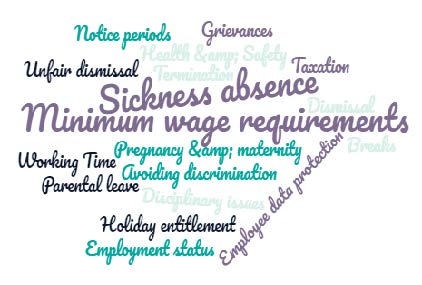Let us start by saying congratulations. If you are considering hiring someone for the first time it means your new business is going well and that in itself if a great achievement.
Starting a business is no easy feat. Now that you are looking to grow, you will not want anything to derail your initial success.
Hiring someone to help you is an inevitable first step that all growing businesses will need to take so you are not alone. It can be daunting to employ someone for the first time but rest assured that there is plenty of help and guidance out there for new employers. We have put together this guide as a starting point for you, to give you an idea of the things you will need to think about and put in place when you take on your first hire, from developing an idea of what you need, through to managing the employment relationship.
Step 1: Identify what help you need & your budget
It might seem obvious but the first step is to spend some time giving real thought to what help you need. Take time to observe the sorts of tasks you are undertaking. Consider which of those tasks you are happy to carry on doing yourself, and which ones you need help with.
It might be that in order to grow your business, you need someone with skills you don’t have. Or you may benefit from someone taking over administration or sales so you can concentrate on the skilled work yourself.
Once you have an idea of the role, do some research to find out what the current market rate is for hiring someone in that sort of role. What salary is usual? Are benefits typically offered in addition to basic salary? Is there any training that you will need to provide, either at the start of the job or on an ongoing basis? Would someone in that role usually be given a company car or car allowance?
You will obviously want to attract good candidates for your new role. An understanding of what is generally offered to new hires will help. But you also need to be realistic about your budget. The cost of hiring an employee is not just the salary you offer them. You need to factor in the cost of employer National Insurance contributions, employer pension contributions, employers’ liability insurance, training costs, supplies, equipment, tech, any software licenses, accounting and legal costs.
Don’t be put off by this though; the point is just to budget realistically and consider all your options.
Step 2: Learn some employment law basics
It’s a good idea to get at least a basic idea of employee rights and your responsibilities as an employer before you hire someone. Not only will this help you avoid unwittingly walking into a claim, but it will also help you understand the choices open to you as an employer.
A good starting point is to have a read through the free guidance provided by the government on the GOV.UK website on employing people which you can find at: http://www.gov.uk/browse/employingpeople.
There is also a wealth of information available from Acas (the Advisory, Conciliation & Arbitration Service) on its website at www.acas.org.uk. Acas is an independent, UK government-funded organisation which provides impartial advice and guidance to both employers and individuals on workplace issues.
There are some areas of employment law that you will want to familiarise yourself with in particular, such as: holiday entitlement and pay, sick leave and pay, discrimination laws, data protection laws, rest breaks, pension entitlements, minimum wage, and unfair dismissal.
If an employee brings a claim against you, it won’t be enough to say: “I didn’t know.” If in doubt at any point, get some advice..
Step 3: Job description and pay
Once you have decided on the role you need, put together a job description so you can advertise the role.
You will also want to set out any particular qualifications or skills that a candidate should have as a minimum, or which you would want them to work towards.
The job description can also be useful later on in the working relationship. Sometimes performance issues come up and the job description or initial job advertisement can sometimes be a helpful reference point to both employer and employee as to your expectations. You will also need to have in mind the range of pay and the types of benefits you are able to offer. Some flexibility in pay is a good idea as you obviously won’t want to pay more than you have to, and certainly not more than you can afford.
It is fairly standard practice for businesses to offer the same types of benefits, such as private health insurance, life insurance, and company sick pay.
But these types of benefits will not necessarily be of interest to everyone.
The benefits you offer to employees over and above their normal pay should be something that is likely to be of interest to the type person you are trying to hire. Something of interest to a Millennial may not be of interest to a mother of teenagers. Think about your demographic and then do your homework. There are loads of companies out there now that specialize in employee benefits and incentives. Even if you don’t use them, they may be the source of an idea.
Remember that you are trying to attract talent. Be proactive about this and sell yourself and your business.
Step 4: Recruitment
There are a number of ways to go about recruiting someone. You could start by making enquiries amongst your connections, through networking or asking for referrals.
You can advertise the role on your website and social media, or through a paid-for job advertising site, such as Indeed, Monster or Reed.
Alternatively, it may pay to have a specialist recruiter to help you. Although this will come at a price, recruiters have connections, they know the market, they can advise on methods to attract the best talent, and may increase your chances of making a good hire.
It takes time to make a good hire. There is a lot to be said for spending the time to get it right the first time.
Step 5: Payroll & PAYE
While you are waiting for applications to come-in, speak with your accountant about setting up a payroll system for you so that you are ready to go.
Payroll is basically a list of employees who work for a business and for whom the employer is responsible for deducting tax and National Insurance contributions via PAYE (or Pay as You Earn).
If you would rather look after your own payroll, you will need payroll software so that you can report to HMRC. You will have to calculate tax and deduct it from your employee’s pay, provide your employee with a pay-slip, and pay the tax deducted over to HMRC. Again, you can go to the GOV.UK website for guidance on setting up your own payroll and for information about payroll software. Go to: http://www.gov.uk/payroll-software.
Step 6: Register with HMRC
You will need to register with HMRC as an employer and get a payroll number. Make sure you leave enough time for this before your employee starts working from you.
Step 7: Job Offer & Contract of Employment
Once you have carried out your interviews and chosen a suitable candidate, you will need to send them an offer letter and a contract of employment.
It is a legal requirement for employers to give their employees or workers (such as casual staff) a statement of the main terms of their employment either before, or at least on, the date they start. Certain information must be included, such as hours, rate of pay, job title, job location and employer details.
A contract of employment can go beyond these minimum requirements though and provide some important protections for employers. It is usually in an employer’s interest to make sure they have a well-drafted contract in place.
Step 8: Pre-employment checks
You should carry out some basic checks before your employee starts working for you. An employee’s identify should be verified by way of photo and address ID.
Employers are also obliged to make sure their employees have the right to work in the UK. This would normally be checked by asking the employee for a copy of their passport or the visa confirming their right to work in the UK.
References should also be checked at this stage.
For some roles, a DBS (Disclosure and Barring Service) check might be required. This is usually only if the role requires the employee to work with vulnerable people.
Step 9: Employers’ Liability Insurance
Employers are legal required to have Employers’ Liability Insurance.
This type of insurance covers employees if they are injured or become ill as a result of working for you. It will need to cover full-time and part-time employees, as well as temporary staff, apprentices, volunteers, and self-employed contractors. If you already have an insurance broker you work with, get in touch with them and they will able to arrange this for you. Otherwise, there are a lot of insurance providers out there and the premiums are not hugely expensive.
Step 10: Pension auto-enrolment
All employers are now obligated to enrol qualifying staff into a pension scheme.
In a nutshell, your obligations are to:
• Have a pension scheme in place;
• Regularly assess your workforce to determine who is eligible for auto-enrolment;
• Auto-enrol anyone who is eligible and pay at least the minimum contributions;
• Keep proper records; and
• Re-enrol anyone who has opted-out when required.
It is advisable to get professional help with your pension obligations as this can be a complicated area for anyone who is new to it. We would suggest that you speak with your account or financial advisor about this early on. There are many options open to employers in addition to the minimum auto-enrolment obligations and it is worth talking those through with your trusted advisor to make sure that both you and your employee are getting the best deal available. And finally… Once you have onboarded your employee, you will want to make sure that you both continue to get what you need from the relationship. Remember that the best employers understand that the relationship is not all about what the employer gets from the employee. The employee also has skin in the game. They want their work to be fulfilling, rewarding, stable, and enjoyable. Together, you can make that happen.
Starting a business is no easy feat. Now that you are looking to grow, you will not want anything to derail your initial success.
Hiring someone to help you is an inevitable first step that all growing businesses will need to take so you are not alone. It can be daunting to employ someone for the first time but rest assured that there is plenty of help and guidance out there for new employers. We have put together this guide as a starting point for you, to give you an idea of the things you will need to think about and put in place when you take on your first hire, from developing an idea of what you need, through to managing the employment relationship.
Step 1: Identify what help you need & your budget
It might seem obvious but the first step is to spend some time giving real thought to what help you need. Take time to observe the sorts of tasks you are undertaking. Consider which of those tasks you are happy to carry on doing yourself, and which ones you need help with.
It might be that in order to grow your business, you need someone with skills you don’t have. Or you may benefit from someone taking over administration or sales so you can concentrate on the skilled work yourself.
Once you have an idea of the role, do some research to find out what the current market rate is for hiring someone in that sort of role. What salary is usual? Are benefits typically offered in addition to basic salary? Is there any training that you will need to provide, either at the start of the job or on an ongoing basis? Would someone in that role usually be given a company car or car allowance?
You will obviously want to attract good candidates for your new role. An understanding of what is generally offered to new hires will help. But you also need to be realistic about your budget. The cost of hiring an employee is not just the salary you offer them. You need to factor in the cost of employer National Insurance contributions, employer pension contributions, employers’ liability insurance, training costs, supplies, equipment, tech, any software licenses, accounting and legal costs.
Don’t be put off by this though; the point is just to budget realistically and consider all your options.
Step 2: Learn some employment law basics
It’s a good idea to get at least a basic idea of employee rights and your responsibilities as an employer before you hire someone. Not only will this help you avoid unwittingly walking into a claim, but it will also help you understand the choices open to you as an employer.
A good starting point is to have a read through the free guidance provided by the government on the GOV.UK website on employing people which you can find at: http://www.gov.uk/browse/employingpeople.
There is also a wealth of information available from Acas (the Advisory, Conciliation & Arbitration Service) on its website at www.acas.org.uk. Acas is an independent, UK government-funded organisation which provides impartial advice and guidance to both employers and individuals on workplace issues.
There are some areas of employment law that you will want to familiarise yourself with in particular, such as: holiday entitlement and pay, sick leave and pay, discrimination laws, data protection laws, rest breaks, pension entitlements, minimum wage, and unfair dismissal.
If an employee brings a claim against you, it won’t be enough to say: “I didn’t know.” If in doubt at any point, get some advice..
Step 3: Job description and pay
Once you have decided on the role you need, put together a job description so you can advertise the role.
You will also want to set out any particular qualifications or skills that a candidate should have as a minimum, or which you would want them to work towards.
The job description can also be useful later on in the working relationship. Sometimes performance issues come up and the job description or initial job advertisement can sometimes be a helpful reference point to both employer and employee as to your expectations. You will also need to have in mind the range of pay and the types of benefits you are able to offer. Some flexibility in pay is a good idea as you obviously won’t want to pay more than you have to, and certainly not more than you can afford.
It is fairly standard practice for businesses to offer the same types of benefits, such as private health insurance, life insurance, and company sick pay.
But these types of benefits will not necessarily be of interest to everyone.
The benefits you offer to employees over and above their normal pay should be something that is likely to be of interest to the type person you are trying to hire. Something of interest to a Millennial may not be of interest to a mother of teenagers. Think about your demographic and then do your homework. There are loads of companies out there now that specialize in employee benefits and incentives. Even if you don’t use them, they may be the source of an idea.
Remember that you are trying to attract talent. Be proactive about this and sell yourself and your business.
Step 4: Recruitment
There are a number of ways to go about recruiting someone. You could start by making enquiries amongst your connections, through networking or asking for referrals.
You can advertise the role on your website and social media, or through a paid-for job advertising site, such as Indeed, Monster or Reed.
Alternatively, it may pay to have a specialist recruiter to help you. Although this will come at a price, recruiters have connections, they know the market, they can advise on methods to attract the best talent, and may increase your chances of making a good hire.
It takes time to make a good hire. There is a lot to be said for spending the time to get it right the first time.
Step 5: Payroll & PAYE
While you are waiting for applications to come-in, speak with your accountant about setting up a payroll system for you so that you are ready to go.
Payroll is basically a list of employees who work for a business and for whom the employer is responsible for deducting tax and National Insurance contributions via PAYE (or Pay as You Earn).
If you would rather look after your own payroll, you will need payroll software so that you can report to HMRC. You will have to calculate tax and deduct it from your employee’s pay, provide your employee with a pay-slip, and pay the tax deducted over to HMRC. Again, you can go to the GOV.UK website for guidance on setting up your own payroll and for information about payroll software. Go to: http://www.gov.uk/payroll-software.
Step 6: Register with HMRC
You will need to register with HMRC as an employer and get a payroll number. Make sure you leave enough time for this before your employee starts working from you.
Step 7: Job Offer & Contract of Employment
Once you have carried out your interviews and chosen a suitable candidate, you will need to send them an offer letter and a contract of employment.
It is a legal requirement for employers to give their employees or workers (such as casual staff) a statement of the main terms of their employment either before, or at least on, the date they start. Certain information must be included, such as hours, rate of pay, job title, job location and employer details.
A contract of employment can go beyond these minimum requirements though and provide some important protections for employers. It is usually in an employer’s interest to make sure they have a well-drafted contract in place.
Step 8: Pre-employment checks
You should carry out some basic checks before your employee starts working for you. An employee’s identify should be verified by way of photo and address ID.
Employers are also obliged to make sure their employees have the right to work in the UK. This would normally be checked by asking the employee for a copy of their passport or the visa confirming their right to work in the UK.
References should also be checked at this stage.
For some roles, a DBS (Disclosure and Barring Service) check might be required. This is usually only if the role requires the employee to work with vulnerable people.
Step 9: Employers’ Liability Insurance
Employers are legal required to have Employers’ Liability Insurance.
This type of insurance covers employees if they are injured or become ill as a result of working for you. It will need to cover full-time and part-time employees, as well as temporary staff, apprentices, volunteers, and self-employed contractors. If you already have an insurance broker you work with, get in touch with them and they will able to arrange this for you. Otherwise, there are a lot of insurance providers out there and the premiums are not hugely expensive.
Step 10: Pension auto-enrolment
All employers are now obligated to enrol qualifying staff into a pension scheme.
In a nutshell, your obligations are to:
• Have a pension scheme in place;
• Regularly assess your workforce to determine who is eligible for auto-enrolment;
• Auto-enrol anyone who is eligible and pay at least the minimum contributions;
• Keep proper records; and
• Re-enrol anyone who has opted-out when required.
It is advisable to get professional help with your pension obligations as this can be a complicated area for anyone who is new to it. We would suggest that you speak with your account or financial advisor about this early on. There are many options open to employers in addition to the minimum auto-enrolment obligations and it is worth talking those through with your trusted advisor to make sure that both you and your employee are getting the best deal available. And finally… Once you have onboarded your employee, you will want to make sure that you both continue to get what you need from the relationship. Remember that the best employers understand that the relationship is not all about what the employer gets from the employee. The employee also has skin in the game. They want their work to be fulfilling, rewarding, stable, and enjoyable. Together, you can make that happen.
Employment Law & HR Glossary
Advisory, Conciliation and Arbitration Service (Acas)
Acas is an independent, UK government-funded organization which provides advice and guidance to employers and individuals on workplace issues. It also provides conciliation services to those involved in Employment Tribunal claims.
Acas Code of Practice on Disciplinary & Grievance Procedures
A code of practice which sets a minimum standard expected of employers when it comes to dealing with grievances and any disciplinary matters.
Automatic enrolment scheme
A pension scheme in which an employer must automatically enrol eligible jobholders in accordance with the Pensions Act 2008.
Automatic Unfair Dismissal
A dismissal for a reason that is automatically unfair even if a fair procedure is followed, such as a dismissal because of maternity or pregnancy, for asserting a statutory right or for being a member of a Trade Union. There is no period of qualifying service for most types of automatic unfair dismissal claim.
Basic salary/pay
An employee’s basic rate of pay or salary excluding any benefits, overtime or allowances.
Benefit
A non-monetary benefit given to an employee in addition to their basic salary or pay such as car allowance, private medical insurance or life assurance.
Bonus
An incentive payment made to an employee generally to reward performance. Bonuses can be discretionary or contractual or a combination of both.
Capability
An employee’s ability to perform their job by reference to their skill, aptitude, qualifications, health or any other physical or mental quality. An employee can potentially be fairly dismissed for capability reasons.
Acas is an independent, UK government-funded organization which provides advice and guidance to employers and individuals on workplace issues. It also provides conciliation services to those involved in Employment Tribunal claims.
Acas Code of Practice on Disciplinary & Grievance Procedures
A code of practice which sets a minimum standard expected of employers when it comes to dealing with grievances and any disciplinary matters.
Automatic enrolment scheme
A pension scheme in which an employer must automatically enrol eligible jobholders in accordance with the Pensions Act 2008.
Automatic Unfair Dismissal
A dismissal for a reason that is automatically unfair even if a fair procedure is followed, such as a dismissal because of maternity or pregnancy, for asserting a statutory right or for being a member of a Trade Union. There is no period of qualifying service for most types of automatic unfair dismissal claim.
Basic salary/pay
An employee’s basic rate of pay or salary excluding any benefits, overtime or allowances.
Benefit
A non-monetary benefit given to an employee in addition to their basic salary or pay such as car allowance, private medical insurance or life assurance.
Bonus
An incentive payment made to an employee generally to reward performance. Bonuses can be discretionary or contractual or a combination of both.
Capability
An employee’s ability to perform their job by reference to their skill, aptitude, qualifications, health or any other physical or mental quality. An employee can potentially be fairly dismissed for capability reasons.
Constructive Dismissal
Where an employee resigns due to a fundamental (or repudiatory) breach of contract by the employer. A constructive dismissal may be an unfair dismissal.
Continuous employment
An employee’s continuous period of service. This is important as a minimum period of service is needed for certain rights and payments such as unfair dismissal, statutory redundancy pay, and statutory maternity pay.
Contract of Employment
A contract of service, which can be oral or in writing, and either expressly agreed or implied.
Discrimination
It is potentially unlawful under the Equality Act 2010 to discriminate on the grounds of a Protected Characteristic (age, disability, gender reassignment, marriage or civil partnership, pregnancy or maternity, race, religion or belief, sex or sexual orientation).
Disciplinary Procedure
A procedure to be followed where an allegation of misconduct is made against an employee. It should take into account the Acas Code of Practice on Disciplinary & Grievance Procedures as a minimum.
Dismissal
Termination of employment by the employer; or resignation by the employee that is a constructive dismissal; or non-renewal of a fixed-term contract.
Employee
An individual who works under a contract of employment (as contrasted with a Worker or self-employed contractor).
Where an employee resigns due to a fundamental (or repudiatory) breach of contract by the employer. A constructive dismissal may be an unfair dismissal.
Continuous employment
An employee’s continuous period of service. This is important as a minimum period of service is needed for certain rights and payments such as unfair dismissal, statutory redundancy pay, and statutory maternity pay.
Contract of Employment
A contract of service, which can be oral or in writing, and either expressly agreed or implied.
Discrimination
It is potentially unlawful under the Equality Act 2010 to discriminate on the grounds of a Protected Characteristic (age, disability, gender reassignment, marriage or civil partnership, pregnancy or maternity, race, religion or belief, sex or sexual orientation).
Disciplinary Procedure
A procedure to be followed where an allegation of misconduct is made against an employee. It should take into account the Acas Code of Practice on Disciplinary & Grievance Procedures as a minimum.
Dismissal
Termination of employment by the employer; or resignation by the employee that is a constructive dismissal; or non-renewal of a fixed-term contract.
Employee
An individual who works under a contract of employment (as contrasted with a Worker or self-employed contractor).
Employment Tribunal
A tribunal which hears and rules on certain disputes arising out of employment.
Equality Act 2010
This is where you will find the law relating to discrimination in Great Britain.
Fixed-term employee
An employee who works under a contract which ends on a particular date or after a set period or occurrence of an event.
Flexible working
Methods of working that differ from standard work pattern such as home working, job-sharing, part-time, term-time, and shift working. Employees with at least 26 weeks’ employment have a right to request flexible working for any reason.
Grievance/ Grievance Procedure
A complaint by an employee about something at work and the procedure that should be followed when dealing with such a complaint.
Health & Safety Executive (HSE) (UK)
Government agency responsible for workplace health & safety regulation and education.
Implied terms
Contractual terms that are implied into contracts by law (rather than having been agreed between the parties) such as the implied duty of trust and confidence, of fidelity, and the duty to provide a safe place of work.
National Minimum Wage (NMW)
The minimum hourly rate that all employers must pay which is set by the government each year which applies to all Workers.
A tribunal which hears and rules on certain disputes arising out of employment.
Equality Act 2010
This is where you will find the law relating to discrimination in Great Britain.
Fixed-term employee
An employee who works under a contract which ends on a particular date or after a set period or occurrence of an event.
Flexible working
Methods of working that differ from standard work pattern such as home working, job-sharing, part-time, term-time, and shift working. Employees with at least 26 weeks’ employment have a right to request flexible working for any reason.
Grievance/ Grievance Procedure
A complaint by an employee about something at work and the procedure that should be followed when dealing with such a complaint.
Health & Safety Executive (HSE) (UK)
Government agency responsible for workplace health & safety regulation and education.
Implied terms
Contractual terms that are implied into contracts by law (rather than having been agreed between the parties) such as the implied duty of trust and confidence, of fidelity, and the duty to provide a safe place of work.
National Minimum Wage (NMW)
The minimum hourly rate that all employers must pay which is set by the government each year which applies to all Workers.
Notice period
The period of notice the employee and employer need to give to terminate the employment (which may not be the same period). There is a statutory minimum notice period and the employer can give more but not less notice than the statutory minimum.
Pay as you earn (PAYE)
Where an employer deducts income tax and employee’s National Insurance Contributions (NIC) from an employee’s gross pay, and pays them (along with employer’s NICs) to HMRC.
Payment in Lieu of Notice
A contractual right to pay an employee a lump sum rather than have them work their notice period.
Privacy Notice
A notice given to an employee, worker or contractor which notifies them about the personal data that will be held by the employer about them, how they can expect that data to be use and for what purpose.
Probationary period
A period at the start of employment where the employee is assessed for suitability to the role.
Protected Characteristics
The characteristics protected by the Equality Act 2010: age, disability, gender reassignment, marriage and civil partnership, pregnancy and maternity, race, religion or belief, sex and sexual orientation.
Redundancy
A situation where an employer reduces the number of employees or closes a workplace. Employees who are redundant may be entitled to a statutory redundancy payment in addition to notice.
The period of notice the employee and employer need to give to terminate the employment (which may not be the same period). There is a statutory minimum notice period and the employer can give more but not less notice than the statutory minimum.
Pay as you earn (PAYE)
Where an employer deducts income tax and employee’s National Insurance Contributions (NIC) from an employee’s gross pay, and pays them (along with employer’s NICs) to HMRC.
Payment in Lieu of Notice
A contractual right to pay an employee a lump sum rather than have them work their notice period.
Privacy Notice
A notice given to an employee, worker or contractor which notifies them about the personal data that will be held by the employer about them, how they can expect that data to be use and for what purpose.
Probationary period
A period at the start of employment where the employee is assessed for suitability to the role.
Protected Characteristics
The characteristics protected by the Equality Act 2010: age, disability, gender reassignment, marriage and civil partnership, pregnancy and maternity, race, religion or belief, sex and sexual orientation.
Redundancy
A situation where an employer reduces the number of employees or closes a workplace. Employees who are redundant may be entitled to a statutory redundancy payment in addition to notice.
Restrictive Covenant (or Post-termination restrictions)
A clause in a contract which restricts what an employee can do after their employment ends. They are used to protect the employer’s business when an employee leaves and usually cover poaching customers or employees, or working for a competitor.
Self-employed independent contractor
Someone who is engaged in business on their own account and is not an employee. They are engaged under a contract for services rather than a contract of service.
Restrictive Covenant (or Post-termination restrictions)
A clause in a contract which restricts what an employee can do after their employment ends. They are used to protect the employer’s business when an employee leaves and usually cover poaching customers or employees, or working for a competitor.
Self-employed independent contractor
Someone who is engaged in business on their own account and is not an employee. They are engaged under a contract for services rather than a contract of service.
Staff Handbook
A handbook containing non-contractual policies and procedures that apply in a workplace.
Statement of Particulars of Employment (Section 1 Statement)
Employers are required to provide employees and workers with a statement of the main terms of their employment on or before their first day of work. Certain information must be provided in this statement.
A clause in a contract which restricts what an employee can do after their employment ends. They are used to protect the employer’s business when an employee leaves and usually cover poaching customers or employees, or working for a competitor.
Self-employed independent contractor
Someone who is engaged in business on their own account and is not an employee. They are engaged under a contract for services rather than a contract of service.
Restrictive Covenant (or Post-termination restrictions)
A clause in a contract which restricts what an employee can do after their employment ends. They are used to protect the employer’s business when an employee leaves and usually cover poaching customers or employees, or working for a competitor.
Self-employed independent contractor
Someone who is engaged in business on their own account and is not an employee. They are engaged under a contract for services rather than a contract of service.
Staff Handbook
A handbook containing non-contractual policies and procedures that apply in a workplace.
Statement of Particulars of Employment (Section 1 Statement)
Employers are required to provide employees and workers with a statement of the main terms of their employment on or before their first day of work. Certain information must be provided in this statement.
Unfair Dismissal
A dismissal of an employee contrary to section 98 of the Employment Rights Act 196. There are five potentially fair reasons for dismissal in the ERA: redundancy, capability, conduct, breach of a statutory restriction or some other substantial reason. The employer must have a fair reason and follow a fair procedure before dismissing.
Whistleblowing
Where an employee makes a qualifying disclosure to an employer or other specified individual or body which is in the public interest concerning a criminal offence, breach of a legal obligation, danger to health & safety, damage to the environment or a miscarriage of justice. Whistleblowers are protected from dismissal or other detrimental treatment on the grounds of their disclosure.
Worker
An individual who works under a contract of employment or any other contract whereby they agree to personally perform work or services for someone who is not their client or customer. Workers are neither employees not self-employed. They have some rights, more than those who are self-employed but less than employees.
A dismissal of an employee contrary to section 98 of the Employment Rights Act 196. There are five potentially fair reasons for dismissal in the ERA: redundancy, capability, conduct, breach of a statutory restriction or some other substantial reason. The employer must have a fair reason and follow a fair procedure before dismissing.
Whistleblowing
Where an employee makes a qualifying disclosure to an employer or other specified individual or body which is in the public interest concerning a criminal offence, breach of a legal obligation, danger to health & safety, damage to the environment or a miscarriage of justice. Whistleblowers are protected from dismissal or other detrimental treatment on the grounds of their disclosure.
Worker
An individual who works under a contract of employment or any other contract whereby they agree to personally perform work or services for someone who is not their client or customer. Workers are neither employees not self-employed. They have some rights, more than those who are self-employed but less than employees.


Further help
If you have any questions about anything in this guide, please get in touch Kim Cross at This email address is being protected from spambots. You need JavaScript enabled to view it. or call 01945 898090.
We would be happy to with you.
This email address is being protected from spambots. You need JavaScript enabled to view it.
www.vinelaw.co.uk
Tel: 01945 898090
LinkedIn – Twitter – Instagram - Facebook
Kim Cross
Partner – Employment & Dispute Resolution
If you have any questions about anything in this guide, please get in touch Kim Cross at This email address is being protected from spambots. You need JavaScript enabled to view it. or call 01945 898090.
We would be happy to with you.
This email address is being protected from spambots. You need JavaScript enabled to view it.
www.vinelaw.co.uk
Tel: 01945 898090
LinkedIn – Twitter – Instagram - Facebook
Kim Cross
Partner – Employment & Dispute Resolution








